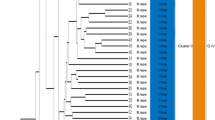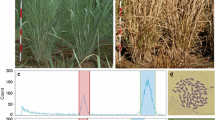Summary
Preliminary analysis using nuclear RFLPs provided evidence that subspecies within Brassica rapa originated from two different centers. One center is in Europe, represented by turnip and turnip rape from which the oilseed sarson was derived. A second center is in South China containing a variety of Chinese vegetables of which pak choi and narinosa seem to be the most ancient forms. Based on RFLP data, the accessions of B. oleracea examined could be divided into three distinct groups, represented by thousand head kale, broccoli and cabbage. Thousand head kale and Chinese kale appear to be the primitive types. Observations of parallel variation among subspecies of both species are discussed.
Similar content being viewed by others
References
Crisp P (1982) The use of an evolutionary scheme for cauli-flowers in the screening of genetic resources. Euphytica 31:725–734
Figdore SS, Kenard W, Song KM, Slocum MK, Osborn TC (1988) Assessment of the degree of restriction fragment length polymorphism in Brassica. Theor Appl Genet 75:833–840
Fitch WM, Margoliash E (1967) Construction of phylogenetic trees. Science 155:279–284
Gray AR (1982) Taxonomy and evolution of broccoli (Brassica oleracea var. italica). Econ Bot 36:397–410
Helm J (1963) Morphologisch-taxonomische Gliederung der Kultursippen von Brassica oleracea L. Kulturpflanze 11:92–210
Li CW (1980) The origin, evolution, taxonomy and hybridization of Chinese cabbage. In:Talekar NS, Griggs TD (eds) Chinese Cabbage. Asian Vegetable Research Center, Taiwan, RO China, pp 1–10
Mithen RF, Lewis BG, Heaney RK, Fenwick GR (1987) Glucosinolates of wild and cultivated Brassica species. Phytochemistry 26:1969–1973
Nieuwhof M (1969) Cole Crops. In: Polunin N (ed) Leonard Hill Book, London, pp 1–25
Osborn TC, Alexander DC, Fobes JF (1987) Identification of restriction fragment length polymorphisms linked to genes controlling soluble solids content in tomato fruit. Theor Appl Genet 73:350–356
Prakash S, Hinata K (1980) Taxonomy, cytogenetics and origin of crop Brassica, a review. Opera Bot 55:1–57
Snogerup S (1980) The wild forms of the Brassica oleracea group (2n=18) and their possible relations to the cultivated ones. In:Tsunoda S, Hinata K, Gomez-Campo C (eds) Brassica Crops and Wild Allies. Jpn Sci Soc Press, Tokyo, pp 121–132
Song KM, Osborn TC, Williams PH (1988) Brassica taxonomy based on nuclear restriction fragment length polymorphism (RFLPs). 1. Genome evolution of diploid and amphidiploid species. Theor Appl Genet 75:784–794
Vaughan JG (1977) A multidisciplinary study of the taxonomy and origin of Brassica crops. BioScience 27:35–40
Zeven AC, Ramanna MS, Boeder M, Sawor Z, Waninge J (1988) Diploids and natural autotetraploids in the predominantly vegetatively propagated Brassica oleracea L. var ramosa DC and their cytology. Euphytica (in press)
Author information
Authors and Affiliations
Additional information
Communicated by G. Wenzel
Rights and permissions
About this article
Cite this article
Song, K.M., Osborn, T.C. & Williams, P.H. Brassica taxonomy based on nuclear restriction fragment length polymorphisms (RFLPs). Theoret. Appl. Genetics 76, 593–600 (1988). https://doi.org/10.1007/BF00260914
Received:
Accepted:
Issue Date:
DOI: https://doi.org/10.1007/BF00260914




